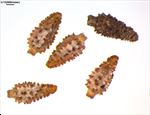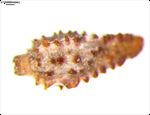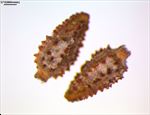Taxonomy
Eleutheranthera ruderalis (Sw.) Sch.Bip., Bot. Zeitung (Berlin) 24:165. 1866Common synonyms
Eleutheranthera areolata Klatt; Eleutheranthera discoidea (Less. ex Less.) M.Gómez; Eleutheranthera discoidea (Less. ex Schlecht) M.Gómez; Eleutheranthera ovalifolia Baill.; Eleutheranthera ovata Poit. ex Steud.; Eleutheranthera prostrata var. leiocarpa (Cass.) Hochr.; Eleutheranthera prostrata var. portoriccensis (DC.) Hochr.; Eleutheranthera ruderalis var. radiata Pruski; Fingalia hexagona Schrank; Gymnopsis microcephala Gardner; Kegelia ramossisima Sch.Bip.; Kegelia ruderalis (Sw.) Sch.Bip.; Melampodium ruderale Sw.; Melampodium ruderalis Sw.; Ogiera eleuthranthera Steud.; Ogiera leiocarpa Cass.; Ogiera ruderalis (Sw.) Griseb.; Ogiera triplinervis Cass.; Ogiera triplinervis var. leiocarpa (Cass.) DC.; Ogiera triplinervis var. portoriccensis DC.; Ogiera triplinervis var. triplinervis; Sigesbeckia portoriccensis Bertero; Sigesbeckia portoriccensis Bertero ex DC.; Verbesina foliacea Spreng.; Wedelia discoidea Less.; Wedelia discoidea Schltdl.; Wedelia eclipta Reich.Common name
Ogiera
Description
Propagule or dispersal unit is the fruit. Fertile part 2.5-3.5 mm long, 1-1.6 mm wide, in side view widest in upper part (obovoid), +/- straight, the upper (apical) end narrowing, in cross-section angular (prismatic), basal scar (carpopodium) inconspicuous and undifferentiated, central, wings absent, fruit surface light brown or straw or dark brown, with round protrusions or bumps, with simple straight hairs, rarely papillae (small protuberances) (by misinterpretation), thickened margin absent, longitudinal ribs present, 4, their surfaces bumpy or notched, with simple straight hairs, rarely papillae (small protuberances) (by misinterpretation).
Pappus absent.
Note: Although there is no pappus the key accommodates interpretation of the narrowed apex of the fruit as a beak of up to 0.5 mm.
Ecology
Herb, seeds without obvious dispersal syndrome. Tropical regions. Found in forests, woodlands, and as a weed of farmlands and disturbed places.
Native range
Tropical America.


